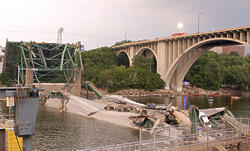Measurements and Standards to Support Advanced Infrastructure Delivery and Resilience
(+$10.6 million)
Challenge

Many of the nation's largest buildings and much of its infrastructure are concentrated in disaster-prone regions where hurricanes, earthquakes, floods and other hazards are common.
The disaster resilience of our structures today is determined in large measure by the building codes, standards, materials, and practices used during their construction. With few exceptions, these legacy codes, standards, materials, and practices, which have evolved over several decades, are prescriptive i.e. not performance-based, oversimplified, and inconsistent.
To allow greater use of innovative structural systems and sustainable materials, there is a critical need to replace prescriptive codes with ones based instead on performance.
There are gaps in the measurement science needed to improve the disaster resilience and sustainability of buildings and infrastructure exposed to natural and man-made hazards. Catastrophic failures in infrastructure cost the U.S. hundreds of billions of dollars in repairs and directly impact our personal and economic health.
Additionally, there is a need to address the decline in the nation's construction productivity, which has averaged 0.6 percent per year over the past four decades. Construction industry leaders see the potential for improvements in construction productivity with integrated and automated processes using advanced technology.
Proposed NIST program
This request funds efforts to provide improvements to our nation's physical infrastructure that will increase the sustainability of materials used and the resilience of our building infrastructure to damage from earthquakes, windstorms, and fire. This funding will also enable U.S. industry to improve productivity by transforming the delivery of construction and infrastructure projects, which represent nearly five percent of our nation's GDP.
NIST proposes to develop critical measurement science tools needed by U.S. industry for:
- risk-based condition assessment of aging infrastructure systems;
- determining the remaining service life—and guiding development and use—of sustainable infrastructure materials;
- ensuring the disaster resilience of structures under extreme conditions specifically e.g., hurricanes, tornadoes, and other windstorms;
- automated access and integration of diverse information systems for infrastructure delivery;
- metrics, standards and guidelines for real-time sensing and monitoring of automated construction at the job site; and
- measuring the productivity impacts of new construction technologies and processes.
Expected impacts
This initiative is focused directly on finding solutions to five of six Grand Challenges identified by the President's National Science and Technology Council in June 2005. It will improve the nation's ability to respond to disasters by:
- providing hazard and disaster information where and when it is needed;
- improving understanding of the natural processes that produce hazards;
- developing hazard mitigation strategies and technologies;
- assessing disaster resilience using standard methods; and
- promoting risk-wise behavior.
This initiative will help prevent hazards from becoming disasters by increasing the resilience of the nation's buildings and infrastructure. The need for response and recovery will be minimized through proactive identification of hazards that pose threats, enabling action to mitigate their potential consequences. The expected impacts of this program will be achieved by:
- advancing the ability to predict assess building and infrastructure conditions, in-service performance of sustainable materials, and building and infrastructure performance in disaster situations;
- enabling the improvement of emergency response and evacuation procedures, and pre-disaster mitigation plans specific to hazard events;
- widely disseminating data, models, and guidelines that yield improvements in standards, codes, and practices;
- enabling the transformation from prescriptive to performance-based design of buildings and infrastructure for fire resistance; and
- enhancing the safety of buildings, infrastructure, emergency responders and the public.
Furthermore, expected U.S. growth will require significant expansion of our existing physical infrastructure, and even small savings in the cost of delivering these projects will result in significant job creation and economic growth. To achieve these savings and increase construction productivity, this program will develop
- an approach for measuring construction productivity to enable separable estimates of contributions at discrete and aggregate levels, and
- a technology readiness index and toolkit to provide effective mechanisms to assess risks and readiness of technologies for integrating and automating the delivery of physical infrastructures.

